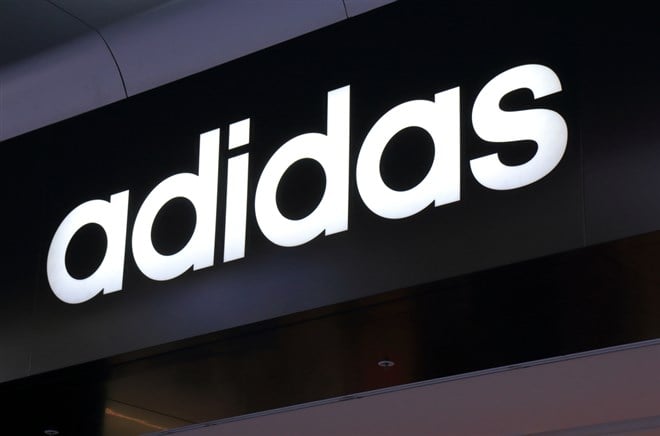The Worst Could be Behind for Adidas After CEO Change Recent negative developments affecting Adidas may finally have come to an end, it will be up to the new CEO's plan for a turnaround to determine investor's fate
This story originally appeared on MarketBeat

The apparel sector has experienced a push on all fronts for most of 2022 and the current year, as indicated by the expanding apparel readings in the United States ISM manufacturing PMI index. The survey results of the index suggest an accelerated expansion in apparel employment, production, prices, and orders in backlog. Such strong momentum has surpassed expectations and yielded pleasant results for equity investors by pushing the stocks in the sector ahead.
This dynamic must feel like a party two blocks over, with loud music and attendees, all of whom are disturbing the uninvited and sleepy Adidas (OTCMKTS: ADDYY), which is facing a possible net loss for the first time in 30 years. Some market participants are calling this the end for the company and subsequent brand, others argue this is far from over for the resilient household global name. Investors would benefit from looking at facts and not stories, here are a few.
"Ye's" Yeezy disaster
Adidas has a long history of successfully partnering with artists, giants in their own disciplines, and launching collaborations and joint collections. However, arguably no figure has been as big or as eccentric as Kanye "Ye" West, who saw Adidas as a peer rather than a financier and a facilitator of sponsorship for his image acceptance in the marketplace. The artist had expressed some unacceptable views on social media venues, which placed Adidas in a corner, having to choose between continued revenue and further brand recognition/penetration or sticking to its reputation and ESG (Environmental, Social and Governance) metrics. Management rightfully chose the latter.
Unfortunately for the apparel company, this decision came after all expenses and costs had been incurred to place the "Yeezy" collaboration in the marketplace, and now the inventory is sitting in question and facing a complete write-off. It is estimated that this inventory can be worth up to $1.3 billion USD, which would greatly affect operations in the firm and effectively bring upon it the first net loss year since three decades ago.
Bad timing
This situation could not have come at a worse time for Adidas, as they have incurred their largest amount of debt in a six-year lookback period, with a debt-to-equity ratio of 123% (60-65% is considered on the upper end of the spectrum). Financial leverage, computed as total assets divided by shareholder's equity, was at 3.8x, while 1.6x to 2.4x is considered "okay" for the industry.
On a different front, China sales declined by 36% in 2022, severely slowing down the company's momentum. As if it weren't enough, inflationary pressures and supply chain issues experienced throughout the year brought gross margins down from a pre-pandemic range of 50-52% to a dismal 47% in 2022. Finally, to top things off, closures in Russia brought upon the company (albeit booked as 'one-offs' thus not affecting normal operations) a total loss of $974 million USD.
Investors who want to have their loyalty tested have to swallow a bitter pill: management has decided to slash dividends by 79% to help cushion the fall of free cash flow in 2022 and the expected operating losses through 2023, a situation the new CEO, Bjorn Gulden, is looking to turn around by 2024.
Outlook
All investors know thus far is that 2023 will be a tough year, and that management is taking on a massive challenge to turn the company around by 2024 and be back to its historical profitability. Management has provided minimal guidance given the massive uncertainty around the Yeezy brand and the global economy. They have pointed toward a high single-digit contraction in net revenues, with an operating loss of approximately 500m EUR.
Given the expected contraction in net revenues and the unhealthy debt levels that the company is carrying, further dividend cuts and suspended buybacks may be in play this year. Currently, inventory levels represent nearly 30% of the company's assets. Even after writing off all of the $1.3 billion USD in Yeezy collections, inventory will still represent around 25% of assets. This elevated inventory level can easily lead to massive discounting activities across stores and online offerings in order to accelerate inventory turnover.
Undeniably, there are a lot of bearish factors working against Adidas. However, trust that management can provide a comprehensive plan to reduce debt and continue to perform as they have for years. China's reopening may provide some momentum to allow new turnaround plans to take place, nonetheless returning to normalized operations - if achieved - can bring the stock to the analyst consensus price target of 155 EUR ($165 USD).
Reasonable technical analyses suggest that the stock has a major support level around the 120-135 EUR range, with some increased volume seen lately encouraging signs of a possible bottom forming soon, logically investors are looking for further developments on just how much the damage will be from the inventory write downs and the implications for dividends and debt unloading attempts.









